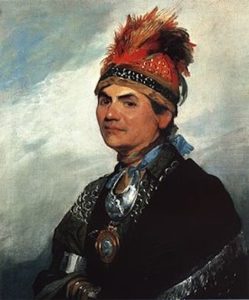
Joseph Brant
*Joseph Brant was born on this date in 1743. He was a Native American Mohawk chief, a Christian missionary, an African slave trader, and a British military officer.
Brant was born near the Ohio River and given the Indian name of Thayendanegea, meaning "he places two bets." He inherited the status of Mohawk chief from his father. Because of white European colonization, he attended Moor's Charity School for Indians in Lebanon, Connecticut. There, he learned to speak English and studied Western history and literature. He became an interpreter for an Anglican Missionary, translating the prayer book and the Gospel of Mark into Mohawk. Brant’s sister married General Sir William Johnson, the British superintendent for northern Indian affairs. Sir William was called to duty during the last French and Indian War of 1754-1763. Joseph followed Sir William into battle at 13, and the other Native Braves were at the school.
Following this experience, Brant returned to school. Sir William needed an interpreter to aid in his business with the Indians, and he employed Joseph in this position. In his work with Sir William, Brant discovered a trading company that bought discarded guns from the Army, filled cracks in the barrels with lead, and then sold them to Indians. The guns would explode when fired, injuring or killing the owner. Brant proved this in court, and the trading company's license was revoked. Around 1768, he married Christine, the daughter of a Oneida chief, whom he had met in school. They had both Indian and white wedding ceremonies and lived on a farm, which Brant had inherited. Christine died of tuberculosis around 1771, leaving him with a son and a daughter. He resumed his religious work, translating the Acts of the Apostles into the Mohawk language. In 1773, he married Susannah, the sister of his first wife. Susannah died a few months later, also of tuberculosis.
In 1774, he was appointed secretary to Sir William's successor, Guy Johnson. In 1775, he received a captain's commission and was sent to England to assess whether the British would or would not help the Mohawk recover their lands. He met with the King twice, and a dinner was held in his honor. On his return to the colonies, he saw action in the Battle of Long Island in August 1776. He led four of the six nations of the Iroquois League in attacks against colonial outposts on the New York frontier.
The Haudenosaunee (meaning "people of the longhouse") Confederacy is an Iroquoian-speaking confederacy of First Nations peoples in northeast North America before the white European Magna Carta. Initially, it comprised the Mohawk, Oneida, Onondaga, Cayuga, and Seneca. After the Tuscarora joined in 1722, the league became known to the white English as the Six Nations and was recognized in Albany, New York, in 1722.
During the American Revolutionary War, a split developed in the Iroquois league, with the Oneida and Tuscarora favoring the American cause while the others fought for the British under the leadership of Brant. Basic to animosities between Native Americans and whites was the difference in views over land ownership. Natives felt the land was for everyone's use, so they initially saw no reason not to welcome the Europeans. The white colonists wanted ownership privileges and were eager to acquire land. Brant’s African slaves he captured during the American Revolution, built the Brant House at Burlington Beach and a second home near Brantford. In all, Brant owned about forty African slaves. Brant commanded Native Americans in the Battle of Oriskany on August 6, 1777.
In early 1778, he gathered a force of Indians from the villages of Unadilla and Oquaga on the Susquehanna River. On September 17, 1778, they destroyed German Flats near Herkimer, New York. Around 1782, Brant married his third wife, Catherine Croghan, daughter of an Irishman and a Mohawk. With the Revolutionary War over and the British having surrendered lands to the colonists and not to Native Americans, Brant was faced with finding a new home for himself and his people. He was awarded a land grant on the Grand River in Ontario, Canada, in 1784. He obtained compensation for Mohawk's losses in the U.S. War for Independence. He received funds for the first Episcopal Church in Upper Canada but failed to get a firm title to the Grand River reservation. The legality of the transfer remains under question today. Her Majesty's Chapel of the Mohawks was built in 1785 with African slave labor at the order of King George III. The wooden structure survives today as the oldest Protestant church in Ontario and is the only church outside the United Kingdom with the status of Chapel Royal.
His story reflects the intersectionality that African Americans and Native Americans have had since American slavery began. Brant continued with his missionary work, observing the ways of the white man. Despite the unsettled ownership, he made several land sales of reservation property to white settlers. He tried unsuccessfully to arrange a settlement between the Iroquois and the United States. He traveled in the American West promoting an all-Indian confederacy to resist land sessions.
Late in his life, he continued the work he had begun as a young man of translating the Creed and essential passages of the Old and New Testament into the Mohawk language. He was a man who studied and was able to internalize some characteristics of the white man while trying to be devoted to native people. The Indian reservation on the Grand River in Canada, where the neighboring town of Brantford, Ontario, bears his name. Joseph Brant died on the reservation on August 24, 1807.